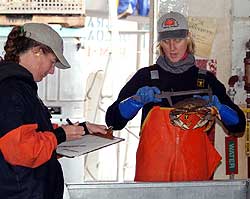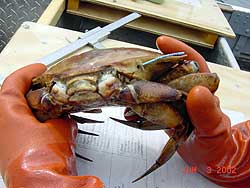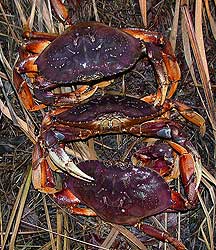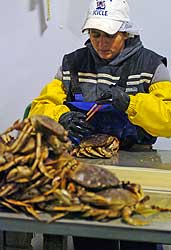
Dungeness Crab Research
Southeast Alaska & Yakutat Commercial Fisheries
Dungeness crab (Cancer magister)
Projects
Southeast survey

From 2000 through 2004, 3,309 commercial pots were set during March/April, June, August/September, and November/December survey periods. Nine discreet survey areas were sampled: Stikine Flats, Duncan Canal, Kah Sheets Bay, Port Camden, Berners Bay, Peril Strait, Tenakee Inlet, St. James Bay, and Seymour Canal. Cluster locations were selected using a systematic sampling design with random start. Clusters consisted of pots in one each of three depth strata and alternated between open and closed escape rings.
Survey CPUE was regressed against commercial harvest. Effects of depth, escape rings, survey period, and year on CPUE and mean carapace width were investigated using ANOVA. Effects of survey period on shell hardness, and female reproductive stage were investigated using logistic regression.
Ratio estimation of exploitation rate
1 “The fishery for Dungeness crab, Cancer magister, in southeastern Alaska is passively managed with regulations governing size, sex, and season. In response to concerns regarding the timing of the commercial season and high exploitation rates, a pot survey program was conducted to investigate the utility of abundance-based management tools. Pre (June) and post-season (August/September) surveys were conducted in seven survey areas: Stikine Flats, Duncan Canal, Port Camden, Berners Bay, Peril Strait, Tenakee Inlet, and St. James Bay from 2000 through 2002. Data were modeled using Change-in-Ratio and Index-Removal methods to estimate legal population size, catchability, and exploitation rates.

The Index-Removal method produced exploitation rate estimates that were biased low due to catchability increasing between the two survey periods; however, Change-in-Ratio population size estimation yielded exploitation rates averaging 93%, and 99% respectively, for Stikine Flats, and Duncan Canal open escape ring pots and 83% and 83% for Peril Strait, and Tenakee Inlet closed escape ring pots. In Port Camden, St. James Bay, and Berners Bay, low, variable, and even negative exploitation rates were estimated, probably as a result of inseason recruitment molts, which violates the assumption of a closed population.
The variable success of the two methods applied here demonstrates a high level of spatial and temporal variability in Dungeness crab life history timing, and makes their assessment very difficult. We suggest that increased variability in life history timing could be a general effect of climate change and result in associated increases in the variability of stock assessments.”

Tagging project
The following is extracted from the extended abstract describing the results of this project.
2 “Seven areas of Southeast Alaska ––Peril Strait, Tenakee Inlet, Port Camden, Duncan Canal, Stikine River Flats, Berners Bay, and St. James Bay––were surveyed twice yearly. Tagging was conducted during seven time periods; postseason––August or September of 2000, 2001, and 2002; and preseason––June of 2001, 2002, 2003, and 2004. However, not all areas were surveyed in each time period. All or a random subsample of male crabs captured were tagged in the posterior margin of the epimural suture immediately posterior to the fourth walking leg on the right hand side as viewed dorsally. To minimize tag loss, a Floy double T-bar anchor rag (FD-94) was used. In all, 7,996 male crabs were tagged. Carapace width of all tagged crabs was measured to the nearest millimeter immediately anterior to the tenth anterolateral spine using vernier calipers. Crab shell condition was visually assessed and categorized and shell hardness of a subsample of tagged crabs was measured using a durometer (Hicks and Johnson 1999). The release sizes ranged from 111 mm to 207 mm CW. As recovery was accomplished almost exclusively through the commercial fishery, tagged crabs recovered either exceeded or were just under the legal size of 165 mm CW––ranging from 157 to 210 mm CW. A total of 1,823 or 23% of tagged crabs were recovered. Carapace width and shell age of all recovered crabs was determined and tag numbers, and recovery dates were recorded. The sizes of over 90% of releases and recoveries were within a range of 140–190 mm CW. Tag-release/recapture data from all seven areas for the period 2000 through 2003 were used to estimate growth increment and molt probability for male Dungeness crabs. This included 744 recaptures. Growth increment was reanalyzed for the 1960s tagging data. Growth increments for the two time periods were statistically compared. The annual molt probability of a male Dungeness crab in Southeast Alaska declined from 100% at 149 mm CW to near 0% by 182 mm CW. . . . . . For the 2000–2003 data for all areas combined, the annual growth increment was constant within the size ranges tagged, with a mean value of 29.91 mm CW.”
Yakutat commercial methods survey

A survey of Dungeness crab populations was conducted in 5 subdistricts of Yakutat, Registration Area D in May of 2004. These five subdistricts were N. of Cape Fairweather, 181-10; N. of Alsek River to N. of Yakutat Bay, 181-60; Yakutat Bay, 183-10; Between Icy Bay and N. of Yakutat Bay, 181-50; and Icy Bay, 181-40. The primary objective of this survey was to determine the catch rate of legal male Dungeness crabs, simulating commercial fishing methods. In order to simulate commercial fishing methods, a captain with experience commercial fishing for Dungeness crab in Registration Area D was one of the selection criteria for the charter vessel. The contractor was directed to pull pots over 7 days, simulating commercial fishing techniques. While individual pot locations and soak times were not predetermined, pot pulls were allocated by subdistrict approximately proportional to the historic harvest distribution.
An ADF&G biologist was stationed onboard the charter vessel to count and sample the catch. Daily, set locations, and set and pull times were recorded for all or a subsample of pots and the contents of the pot recorded. The Dungeness crabs were measured, shell condition, leg condition and reproductive status of the females was determined, if time permitted. Bycatch species were also counted and recorded for each pot. All crabs were returned to the water after sampling.
A total of 605 pots were set of which 425 pots were sampled for crab. A total of 32 sublegal, 57 legal, and 38 unmeasured males, and 33 female Dungeness crabs caught in the sampled pots. Only 1 of the 33 females captured was ovigerous. The soak times ranged from 15–48 hours. Most pots were set in 3 - 10 fathoms water depth. There were a couple of pots that were set in 10–20 fathoms. For comparison purposes, a cursory examination of fish ticket data from Registration Area D shows that for fish tickets on which pot lifts were recorded the catch rate ranged from 3.4 – 4.5 pounds/pot or 1.7 – 2.3 crabs/pot (assuming a 2 lb average) from 1995 – 1999 prior to the closure of the fishery.
Dockside sampling
The data collected during dockside sampling are used to generate size frequencies by fishing area for the commercial Dungeness crab fishery. Port sampling data is useful in determining stock composition. Size frequencies and shell condition information is also useful for evaluating year class cohorts. Information on limb loss, disease, and carapace injuries, and soft shell measures are also useful for gauging overall population health.
Publications authored by ADF&G Staff or contractors
- ADF&G. 1999. Preliminary Report to the Alaska Board of Fisheries. Collapsed or Recovering Shellfish Fisheries in the State of Alaska. Alaska Department of Fish and Game (PDF 118 kB), Regional Information Report #1J02-06, Douglas, October, 1999, 44 pp.
- 1Bishop, G., J. Rumble, and C. Siddon. In Press. Change-in-Ratio and Index-Removal Population Estimation of Dungeness Crab in Southeastern Alaska. 25th Lowell Wakefield Fisheries Symposium: Biology and Management of Exploited Crab Populations under Climate Change. University of Alaska, Sea Grant, Anchorage, AK.
- 2Bishop, G. H., M. S. M. Siddeek, and J. M. Rumble. 2008. Growth of male Dungeness crabs in southeastern Alaska. Pages 1339-1342 In: J. Nielsen, and coeditors, editors. Reconciling Fisheries with Conservation: Proceedings of the Fourth World Fisheries Congress. American Fisheries Society, Vancouver.
- Bishop, G. H., and J. Stratman. 2006. Report to the Alaska Board of Fisheries, 2006 Shrimp, Dungeness Crab and Scallop Fisheries of Southeast Alaska (PDF 1,015 kB). Alaska Department of Fish and Game, Fisheries Management Report #06-03, Juneau, January 2006, 94 pp.
- Bishop, G. H., J. M. Rumble, and S. E. Merkouris. 2001. Southeast Alaska Commercial Dungeness crab 2001/2002 Season Management Plan (PDF 505 kB). Alaska Department of Fish and Game, Regional Information Report #1J01-16, Douglas, Alaska, May 2001, 17 pp.
- George, G., M. Kookesh, D. Mills, and J. Fall. 1985. The Non-commercial Harvest of Crab in Southeast Alaska: A Summary of Available Information (PDF 1,977 kB). Alaska Department of Fish and Game, Division of Subsistence Technical Paper #103, Juneau, March 1985, 30 pp.
- Hebert, K., and coauthors. 2008. 2009 Report to the Board of Fisheries on Region 1 Shrimp, Crab, and Scallop Fisheries (PDF 2,988 kB). Alaska Department of Fish and Game, Commercial Fisheries Division, Fisheries Management Report #08-62, 210 pp.
- Hebert, K., G. H. Bishop, J. M. Rumble, D. C. Love, and M. Pritchett. 2002. Report to the Board of Fisheries, Shellfish Fisheries, Region I: Southeast Alaska - Yakutat (PDF 1,578 kB). Alaska Department of Fish and Game, Regional Information Report #1J02-45, Juneau, November 2002, 150 pp.
- Koeneman, T. M. 1985. A brief review of the commercial fisheries for Cancer magister in Southeast Alaska and Yakutat waters, with emphasis on recent seasons. Pages 393-399 In: B. R. Melteff, editor. Proceedings of the Symposium on Dungeness Crab Biology and Management, Volume 85-3,393-399. University of Alaska Sea Grant College Program.
- Kruse, G. H., D. Hicks, and M. C. Murphy. 1994. Handling increases mortality of softshell Dungeness crabs returned to the sea (PDF 75 kB). Fishery Research Bulletin 1(1):1-9.
- Pitcher, K. W. 1988. Potential Conflicts Between Sea Otters and the Human Utilization of Shellfish in Southeastern Alaska. Department of Fish and Game, Interim Report #6-15-88, 1-25 pp.
- Siddeek, M., B. Sainte-Marie, J. Boutillier, and G. Bishop. 2004. Comparison of reference points estimated using a size-based method for two high-latitude crab species in the United States and Canada. Canadian Journal of Fisheries and Aquatic Sciences 61:1404-1430.
- Woodby, D. A., and coauthors. 2000. Report to the Board of Fisheries, Shellfish Fisheries, Region I: Southeast Alaska - Yakutat (PDF 6,494 kB). Alaska Department of Fish and Game, Commercial Fisheries Division, Regional Information Report #1J99-47, Juneau, 150 pp.
![]() Adobe Acrobat PDF files require a free viewer available directly from Adobe.
Adobe Acrobat PDF files require a free viewer available directly from Adobe.
